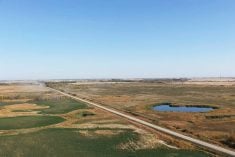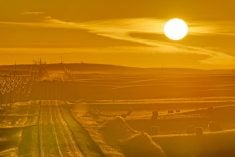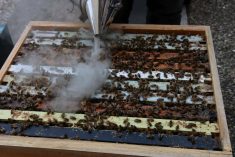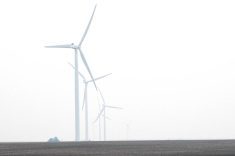This piece deals with long-term water table records as a basis for tracing long-ago annual precipitation. I am dedicating this to the memory of Bill Meneley (1933-2000), who was responsible for establishing the observation wells, which are the basis of what I have to say. He started that work while with the Saskatchewan Research Council. Bill made sure sites were selected that would not be affected by pumping from nearby wells. The wells would measure the water balance of Mother Nature.
When Bill went private, he and I worked together on many projects. Without his help, we would not have reached first base in the soil salinity work of the 1980s and ’90s. Readers who have Henry’s Handbook will see Meneley’s contributions on several pages.
Read Also

Claas brings 1000 Series SP forage harvesters to Canada
In mid-August, Claas unveiled its new line of Jaguar forage harvesters at an event in Visalia, California, deep in the heart of that state’s dairy region.
After coming out of the worst drought in 20 years, rain for 2022 is top of mind as farmers plan next year’s crops. Soil moisture reserves as of freeze-up were next to nil in many areas. Help from snow plus adequate rain will be needed on a timely schedule to get a decent crop.
Folks that study historic precipitation far back in history via tree rings, etc., suggest that 30-year droughts have been experienced in the past and we should expect that to happen again. Does that mean we will have 30 years with very poor crops? I think not, but it could well mean that water will be the limiting factor in some areas, particularly the brown and dark brown soil zones (Palliser Triangle).
Long-term water levels in observation wells are another way to trace past weather. The observation wells that Bill started in the 1960s are now maintained by the Water Security Agency of Saskatchewan located in Moose Jaw. That data is all easily available at wsask.ca.
Only wells completed in surficial aquifers will provide the answer we want. If water comes in faster than it can dissipate by vertical and/or horizontal flow, the water level will rise. If the water coming in is reduced, the water level in the well will drop. It is the cumulative effects over many years that drive the ups and downs. It is much like a bank account.
Time for some facts
I interpret the water levels in the Melfort observation well as a net cumulative 30-year drought from 1975 to 2005 (see Figure 1 below). Some would interpret the 1985 and 1995 “blips” as the sunspot cycle, but I have no way to form an opinion on that issue.

The big snow of 2004-05, turned the impending wreck around, and the 20 inches of rain in 2010 provided another big kick. From about 2012-15 was an equilibrium position, and 2016 brought the level to a peak. During the years from 2012-19 there were some very dry periods.
However, the water table was a factor in many areas and that is what grew great crops with little rain. It was 2012 when I first realized the water table was a factor on my Dundurn farm. I proved it to my skeptical neighbours by installing my own shallow (10-foot) observation wells by hand — materials cost less than $10.
The Goodale farm near Saskatoon
Just in case skeptical readers think Melfort is a “one-off,” here is another example (see Figure 2 below).

The University of Saskatchewan Goodale Farm observation well near Saskatoon has almost the same signature as the Melfort example. It was not installed until 1974 and the 2016 blip is not as evident, but obviously they are dancing to the same drummer.
In both cases, we are back to where we were in 1985. I am not in the business of predicting anything about future rain, but it is a bit sobering.
Let’s go back just a bit further
This example takes us right back to 1916, when my grandfather Jerome Henry was laughing all the way to the bank. There was a series of years that produced great yields of wheat with nothing but the seed in the ground, and the wheat was sold for a huge price ($35 per bushel in today’s dollars).
This example (see Figure 3 below) is also credited to the same Bill Meneley mentioned above. It is redrawn from Figure 3 of the 1987 report “Land Suitability for Irrigation West of the South Saskatchewan River” by Meneley,W.A., Henry, J.L., Cameron, D.R. and Christiansen, E.A. It was a report prepared for the then-Saskatchewan Water Corporation. Bill jokingly called it “The West Side Story.” Meneley was a character — gone but not easily forgotten.

The “cumulative departure” does just that — it accumulates from year to year the difference between that year’s precipitation and the long-term average. The striking thing is the sharp turnaround in the early 1940s.
Meneley had been involved in the first work on the Westside Irrigation Project in the early 1970s. His first report (1970) was as an employee of the Saskatchewan Research Council, but his second report (1971) was as a private consultant. At that time, he used data from the old 1935 comprehensive water well survey of farm wells. He located some of those wells still in operation and measured the water level 35 years later. That convinced him water level fluctuations were large and long-term observation wells were a must. How right he was. Meneley was usually right.
So, there you have it! Mother Nature has her cycles and the more we can learn about them the better we will be able to manage the land and grow crops profitably.
The long-term cycles are the climate, but farmers must manage what the weather throws at us in any given year. As the winter rolls on, I have a few tips I will offer about managing around Mother Nature by using all the facts we can lay our hands on.
















